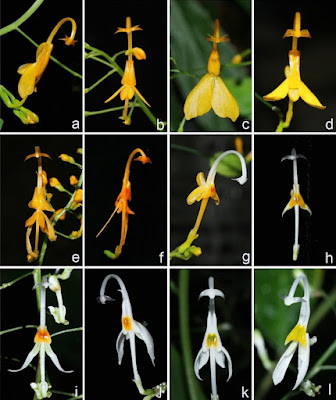 |
| Globba pelecanthera Sangvir. & M.F.Newman, in Sangvirotjanapat, Fér, Denduangboripant et Newman, 2022. |
Abstract
A molecular systematic study of Globba section Nudae (Zingiberaceae) using ITS and matK sequences identifies three major clades, Globba subsection Nudae, G. subsection Mediocalcaratae and a new subsection, Globba subsection Pelecantherae, which is described here. The two species belonging in this subsection, Globba pelecanthera and Globba securifer, which are both new, are described. Rectangular anther appendages are reported in Globba for the first time. Evidence of hybridisation is given. The morphological characters of the flowers, which are likely to be important in pollination, are discussed.
Keywords: Anther appendages, Floral evolution, Hybridisation, Taxonomy
Globba subgenus Globba
section Nudae
subsection Pelecantherae Sangvir., subsect. nova.
Diagnosis: Belonging to Globba section Nudae by the occurrence of andromonoecy, the ellipsoid fruit with deep, longitudinal furrows and resembling subsection Mediocalcaratae by the anthers with two appendages but differing by the rectangular appendages (not acute) and elliptic to obovate lateral staminodes.
Type species: Globba pelecanthera Sangvir. & M.F.Newman.
Distribution: Cambodia (Mondul Kiri), Laos (Bolikhamxay, Attapeu), Thailand (Ubon Ratchathani).
Notes: Globba pelecanthera and G. securifer belong to Globba section Nudae by their erect inflorescences, small, caducous bracts, the occurrence of andromonoecy and ellipsoid, deeply ridged fruits but both species bear rectangular anther appendages which distinguish them from all species of subsections Nudae and Mediocalcaratae which bear triangular or linear anther appendages. This character, taken with the molecular systematic evidence presented above, justifies the recognition of a new subsection.
Globba pelecanthera Sangvir. & M.F.Newman, sp. nov.
Diagnosis: Similar to Globba ranongensis Picheans. & Tiyaw. by its obovate to elliptic lateral staminodes, but differing by its rectangular anther appendages, 2.5 × 1.5 mm (vs. subtriangular (⚥) or linear (♂)), narrowly rectangular lip, 8.5 × 2.5 mm (vs. deltoid, 5–7 × 7–9 mm), and sandstone habitat (vs. limestone plant).
Etymology: Greek, combining ‘pelekus’ (axe) and ‘anthera’, describing the axe-shaped anther appendages.
Globba securifer Sangvir. & M.F.Newman, sp. nov.
Diagnosis: Similar to Globba ranongensis Picheans. & Tiyaw. in its elliptic blades and plain yellow flowers, but differing by its rectangular anther appendages, 2.5 × 1.5 mm (vs. triangular (⚥) or linear (♂)) and sandstone habitat (vs. limestone plant).
Etymology: Securifer means ‘axe-bearing’ in Latin. This epithet, like pelecanthera, refers to the axe-shaped anther appendages of the flower.
Conclusions:
By adding a much more complete representation of the species and geographical range of section Nudae, we have demonstrated the need for a new subsection, as well as confirming that the two existing subsections are monophyletic.
There are now 28 species in Globba section Nudae, classified among three subsections. Globba subsection Nudae is most diverse in the Northern Floristic Province of Thailand and extends north and westwards, while Globba subsection Mediocalcaratae has a more southerly distribution with species north and south of the Isthmus of Kra. Lastly, the new subsection Pelecantherae is found further east in areas with a very strong dry season.
More study is required, particularly in Myanmar, Bangladesh and India to complete our knowledge of species distributions in these countries and to clarify the status of the doubtful species mentioned by Sangvirotjanapat et al. (2019a).
Hybridisation has been observed, but our methods do not allow much more to be said at present. Further studies using population genetics techniques will shed light on this question.
Sunisa Sangvirotjanapat, Tomáš Fér, Jessada Denduangboripant and Mark F. Newman. 2022. Phylogeny of Globba section Nudae and Taxonomic Revision of the new Globba subsection Pelecantherae. Plant Systematics and Evolution. 308: 5. DOI: 10.1007/s00606-021-01789-6



